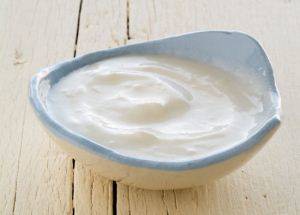Worldwide, cow's milk is most commonly used to make yoghurt, but milk from water buffalo, goats, sheep, camels and yaks is also used in various parts of the world. In theory, the milk of any mammal could be used to make yoghurt. (Soya yoghurt, a non-dairy yoghurt alternative, is made from soy milk.) Dairy yoghurt is produced using a culture of Lactobacillus delbrueckii subsp. bulgaricus and Streptococcus salivarius subsp. thermophilus bacteria. In addition, Lactobacillus acidophilus, bifidobacteria and Lactobacillus casei are also sometimes added during or after culturing yoghurt.
The milk is first heated to about 80 °C (176 °F) to kill any undesirable bacteria and to denature the milk proteins so that they set together rather than form curds. The milk is then cooled to about 45 °C (112 °F). The bacteria culture is added, and the temperature is maintained for 4 to 7 hours to allow fermentation.




